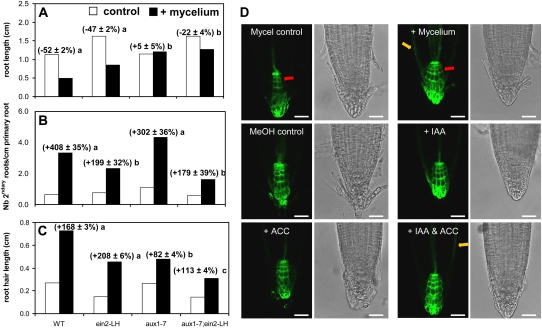Figure 6.
Screening Arabidopsis mutants for resistance to truffle metabolites. Using the bioassay setup of Figure 1, the auxin aux1-7, ethylene ein2-LH, and double mutant aux1-7;ein2-LH were tested for their sensitivity to truffle (T. borchii strain 1) metabolites and compared to the wild type. A to C, Primary root length (A), root branching (B), and root hair length (C). Bars represent average values for 10-d-old seedlings, n > 20 seedlings/treatment; for root hair length n = 300, 15-d-old seedlings. Percentages represent changes versus respective controls (±ses). Different letters indicates statistically different values (P < 0.05, ANOVA on ranks and posthoc Dunn's test). D, Root tips of the Arabidopsis auxin reporter line DR5∷GFP. The mycelium increased the GFP signal intensity at the level of the first tier columnella cells (red arrows) and at the level of the epidermis (yellow arrows) compared to the mycelium control in DR5∷GFP roots. Hormones including IAA (0.1 μm) and ACC (1.0 μm) mimicked this increase in signal intensity fully when applied together (+IAA and ACC; D). For quantification of the GFP signal, refer to Supplemental Figure S7. MeOH control = control for the IAA, ACC, and IAA and ACC treatments. Scale bars in D = 25 μm.

